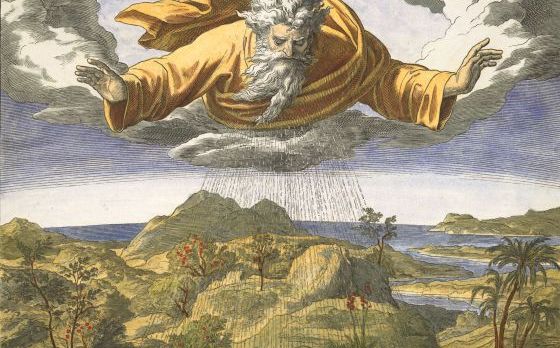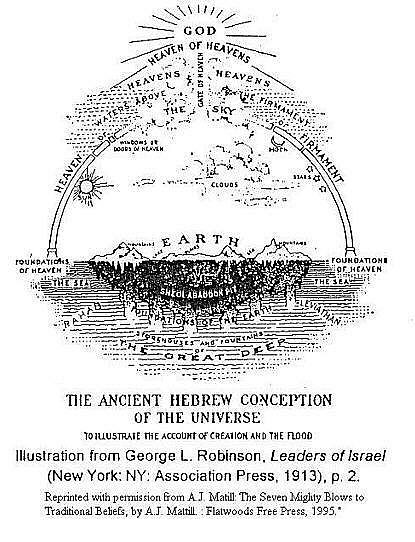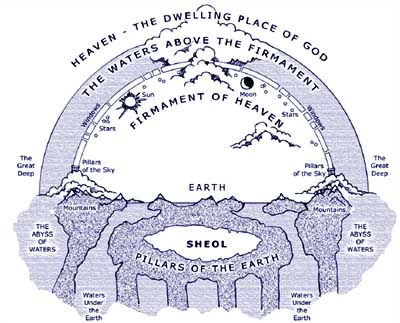Here is as good a meaning as you will get.
The firmament is the curve of the sky, especially if you imagine it as a solid surface. You can describe the sky at night as a firmament shining with stars.
The word firmament comes from the Latin firmus, or "firm," and this description of the sky as something solid reflects ancient ideas of the way the universe was constructed. The first stargazers imagined the sky as a sphere,
My understanding of the firmament is the space created as the universe. Both FEs and GEs know that outside the Earth is that space. As for the waters well the clouds for one are waters and they are separated from the part of the firmament between the Earth and the clouds. There is no big mystery to this as some make out. These same waters would be used by God to flood the whole Earth.
So, let us see this in the light of the private revelations to Sister Mary of Jesus, known as Mary of Agreda (1602-1665), a nun known to have bilocated over 500 times to America without leaving her convent in Spain. The following are insights, dictated to her, she said, by the Virgin Mary herself in 1637, a mere four years after Galileo’s trial. Her three-volume work was entitled; ‘The Mystical City of God’ also known as ‘The Divine History and Life of the Virgin Mother of God.’ These revelations to Venerable Maria, whose body now lies miraculously incorrupt in a Franciscan Monastery in Spain, have withstood many years of investigation and even misinterpretation that caused them to be placed on the Index in 1681 but lifted after 3 months of inspection before receiving approbations from popes as a way to gain a deeper understanding of the Catholic faith in line with traditional Church teaching.
Mary of Agreda wrote: 'In the same instant, and as it were in the third and last place, God determined to create a locality and an abode, where the incarnate Word and his Mother should converse and dwell. For them primarily He created the heaven [the firmament] and Earth with its stars and elements and all that is contained in them . Of the first day Moses says that “In the beginning God created heaven and Earth.” And before creating intellectual and rational creatures, desiring also the order of executing these works to be most perfect, He created heaven for angels and men, and the Earth as a place of pilgrimage for mortals. These places are so adapted to their end and so perfect that as [King] David says of them, the heavens publish the glory of the Lord, the firmament and the Earth announce the glory of the work of his hands (Ps.18:2)… Of the Earth Moses says that it was void, which he does not say of the heavens, for God had created the angels at the instant indicated by the word of Moses: “God said: Let there be light, and light was made.” He speaks here not only of material light, but also of the intellectual or angelic lights… God created the Earth co-jointly with the heavens in order to call into existence hell in its centre; for, at the instant of its creation, there were left in the interior of that globe, spacious and wide cavities, suitable for hell, purgatory and limbo. And in hell was created at the same time material fire and other requisites, which now serve for the punishment of the damned.'
So do you believe in the ever expanding universe and outer space? The Ein Sof?
Is there a circle that surrounds the ball earth? A circle at the edge of the ever expanding universe where Heaven begins?
I've never seen a picture of it. Have you?
Mary of Agreda's depiction seems compatible to this:
 When the Earth was flat: a map of the universe, according to the Old Testament
When the Earth was flat: a map of the universe, according to the Old Testament
Ancient Hebrew cosmology is full of subtleties that often go unnoticed by the contemporary reader
In a nutshell, ancient Hebrew cosmology, as found in the Old Testament, considers the world in which we live a relatively flat disk, covered by a dome. Something like a gigantic cake stand covered with one of those classic glass domes, if you will.
As you can see in the diagram included, below the disk you would find the Sheol (that is, the place of the dead, but not necessarily Hell; actually, this Sheol is a bit more like what the Greeks called Hades) and the so-called “deep waters”, the “waters underneath” or, even more dramatically, “the great deep.”
Now above the dome, in the “outside” of the dome (who’d say?) you’d find even more water. You guessed it right: those are the “upper waters” and, above them, the “high heaven” or the “heaven of heavens”, where God Himself dwells, as can be seen in the graphic.

In a nutshell, ancient Hebrew cosmology, as found in the Old Testament, considers the world in which we live a relatively flat disk covered by a dome. Something like a gigantic cake stand covered with one of those classic glass or acrylic domes, if you will.
For example, both Greeks and Romans assumed that the sky was a glass dome to which the “fixed stars” (that is, celestial bodies which did not seem to move, in relation to other stars in the night sky) were attached. However, there were some discrepancies about the material this dome was allegedly made out of. Some would say it was not made out of glass but iron or bronze instead but, of course, you can tell that was indeed hard to prove. That the Hebrews had similar ideas to those of their Mediterranean neighbors, can be clearly seen in several biblical passages.
The “firmament,” on the other hand, was considered as a sort of gap (or barrier) separating the “upper waters,” which are above the heavens, and the “lower waters” of the deep. The latter would include seas and oceans.
Now the dome covering the Earth was considered to be sitting on pillars, which were thought to be the “foundations of the earth,” and the dome itself had a series of windows, hatches or doors where the rain would fall from, descending from the “upper waters.” The most famous example of the opening of these hatches is, of course, Noah’s Flood.

As with most concepts and notions related to biblical eschatology and cosmology, there are debates about the interpretation of these passages.
Last but not least, deep within the Earth you would find Sheol. Etymologically speaking, it has been commonly assumed that the word “Sheol” comes from a Hebrew root which means “being sunk in,” “being hollow” or even “being buried in.” Consequently, it was only natural to assume that “Sheol” was either a cave, or a place down beneath the earth. In the Septuagint (the first Greek translation of the Old Testament), “Sheol” was translated using the classic Greek word “Hades,” while in the Vulgate (the Latin version), it was translated as “Inferos.”
Anyhow, in this particular case, the word “hell” is used in a very general sense to refer to (at least according to the kind of eschatology that can be found in the Old Testament) the realm of the dead, both the good and the bad.
In a sense, this “Sheol” can be thought of as less like “hell” than like a “limbo,” where the righteous waited for the death and resurrection of Christ, but since this “limbo of the righteous” disappeared after the Harrowing of Hell in the New Testament, “Sheol” often refers to the hell of the damned instead.